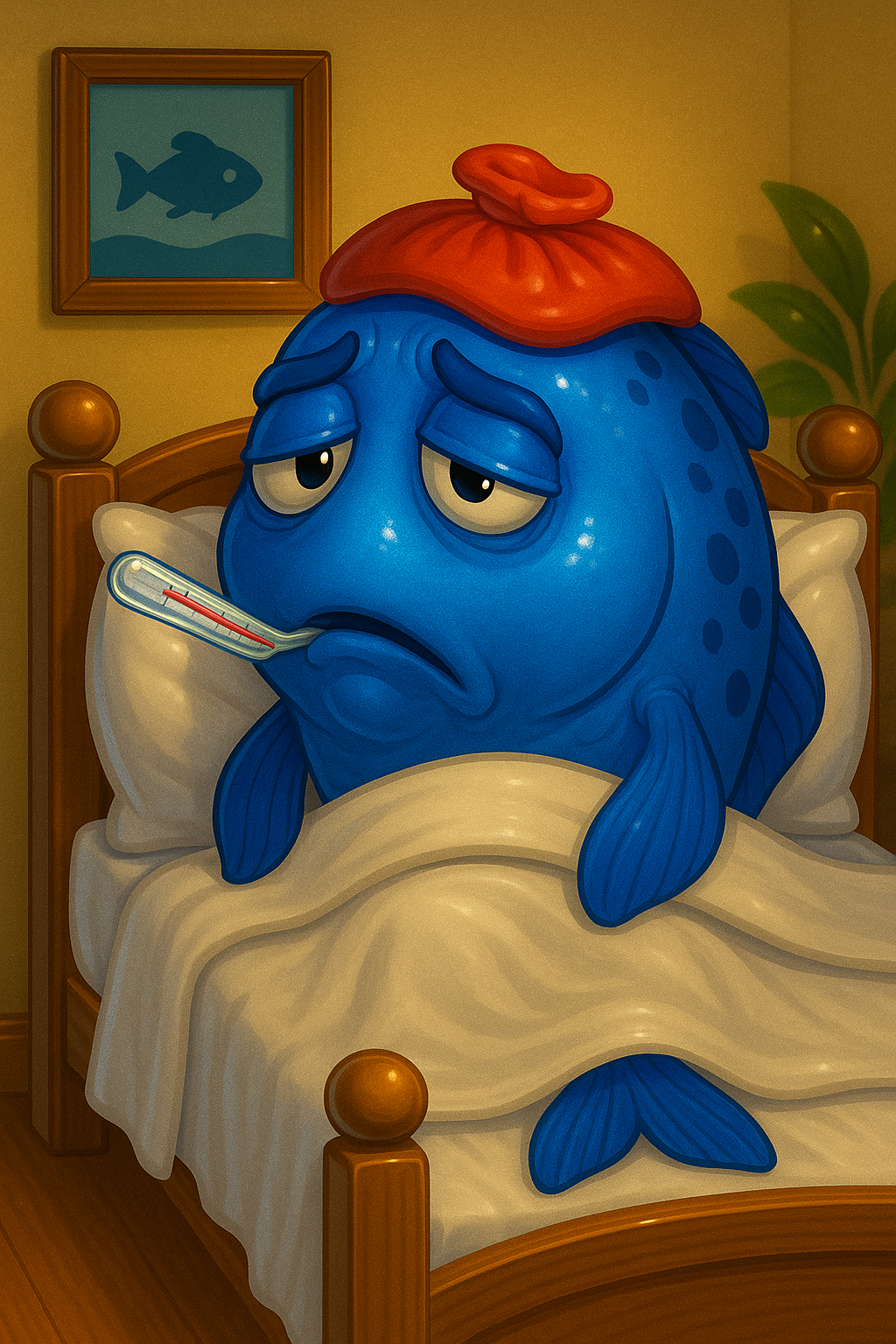What to Do if Your Aquarium Fish Are Sick?
🐟🩺 What to Do if Your Aquarium Fish Are Sick
🔎 Step 1: Identify Symptoms
🐟 Physical Symptoms
- ⚪ White spots → Ich (Ick) — or possibly Epistylis (commonly confused!)
- 🩸 Red streaks or sores → Bacterial infection
- 🦠 Cotton-like patches → Fungal infection OR Columnaris (bacterial “cotton wool”)
- ✂️ Frayed fins → Fin rot
- 🎈 Bloating → Swim bladder disorder, constipation, parasites
- 🪱 Visible worms/eggs → Parasites
- 🫁 Gasping → Ammonia burn, gill flukes, low oxygen
😟 Behavioral Symptoms
- 💤 Lethargy
- 🌀 Erratic swimming
- 🧽 Flashing (scratching on surfaces)
- 🍽️ Loss of appetite
- 🫀 Rapid gill movement
⚠️ Important Note on Diagnosis
Some fish illnesses look almost identical:
- ❄️ Ich vs. Epistylis → Both look like white spots, but ich responds to heat + ich meds, while Epistylis needs antibacterial treatment.
- 🍄 Fungus vs. Columnaris → Fungus = true fungal infection on dead tissue; Columnaris = bacterial, looks like “cotton” but needs antibiotics.
- ✂️ Fin Rot vs. Aggression Damage → Fin rot shows tissue breakdown; aggression leaves torn, uneven bites.
👉 Misdiagnosis is common. Always test water first, then treat carefully.
🪣 Step 2: Quarantine the Sick Fish
- 🚧 Move to hospital tank.
- 🛡️ Prevents spread.
- 💊 Allows targeted treatment.
- 🧼 Keep simple: bare bottom, heater, sponge filter, airstone.
💧 Step 3: Test & Fix Water Quality
- Ammonia → 0 ppm
- Nitrite → 0 ppm
- Nitrate → <20–40 ppm
- pH → Stable
- Temp → Appropriate for species
Bad water quality = stressed, sick fish.
💊 Step 4: Begin Treatment (Choose Carefully)
- ❄️ Ich → Heat + ich medication.
- 🦠 Epistylis → Antibiotics (kanamycin, furan-2).
- 🍄 True Fungus → Antifungal meds (methylene blue, salt dips).
- 🦠 Columnaris → Broad-spectrum antibiotics.
- ✂️ Fin Rot → Water changes + antibiotics or antibacterial meds.
- 🪱 Parasites → Praziquantel, copper-based meds, or metronidazole.
- 🎈 Swim Bladder Issues → Fasting, peas, possibly antibiotics.
💊 Be Prepared: Stock a Fish Medicine Cabinet
Don’t wait until you see sick fish to order meds — by the time they arrive, it may be too late. Just like we keep aspirin for headaches or cough syrup for colds, your fish need fast relief too.
🧴 Recommended Medications to Keep on Hand
- ❄️ Ich Treatment (malachite green, copper, formalin-based)
- 🦠 Broad-Spectrum Antibiotic (kanamycin, erythromycin, furan-2)
- 🍄 Antifungal (methylene blue)
- 🪱 Anti-Parasite Meds (praziquantel, metronidazole, copper)
- 🧂 Aquarium Salt (general support, mild infections, stress relief)
- 🌿 Stress Coat/Dechlorinator (improves slime coat, reduces stress)
👉 Having a well-stocked fish medicine kit allows you to start treatment immediately and saves precious time when fish are at risk.
🍽️ Step 5: Supportive Care
- 🌑 Dim lights to reduce stress.
- 🚫 Remove uneaten food.
- 💨 Boost aeration.
- 🌡️ Keep temperature stable.
- 🍲 Offer vitamin-rich, high-quality foods.
🕒 Step 6: Monitor Daily
- 👀 Watch for improvement/worsening.
- 🐟 Check other fish for symptoms.
- ⏳ Finish full treatment course.
- 📝 Keep notes for future reference.
🛡️ Prevention Tips
- 🪣 Quarantine new arrivals (2–4 weeks).
- 💧 Weekly water changes (20–50%).
- 🚫 Avoid overcrowding.
- 🍽️ Don’t overfeed.
- 🧼 Sterilize equipment between tanks.
📝 Quick Symptom Confusion Chart
| Symptom | Could Be | Key Difference |
|---|---|---|
| ⚪ White spots | Ich OR Epistylis | Ich = responds to ich meds. Epistylis = bacterial, needs antibiotics. |
| 🦠 Cotton patches | Fungus OR Columnaris | Fungus = true fungus. Columnaris = bacterial “cotton”. |
| ✂️ Frayed fins | Fin rot OR Aggression | Rot = tissue decay. Aggression = bite marks/tears. |
| 🫁 Gasping at surface | Oxygen issue OR Gill Flukes | Test water first. If clean → parasite more likely. |
⚡ Golden Rule:
- Test water first.
- Quarantine if possible.
- Treat with the correct medication.
- Keep a stocked medicine cabinet so you’re always ready.

Impulsada por Lightspeed
Mostrar precios en:USD